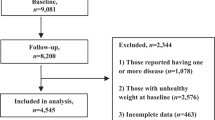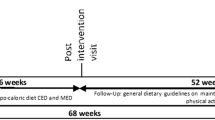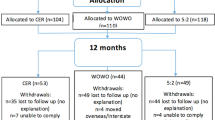Abstract
Objective: This study examined the reported intake of foods and nutrients, and biomarkers of dietary exposure and cardiovascular disease in relation to history of trying to lose weight.
Methods: Dietary, anthropometric and biochemical data were from the third National Health and Nutrition Examination Survey (1988–1994), n=13 092. The history of attempting weight loss variable was created as follows: trying to lose currently and tried in the past 12 months (Y/Y); trying to lose currently, but not tried in the past 12 months (Y/N), not trying currently, but tried in the past 12 months (N/Y); not trying now and not tried in the past 12 months (N/N). Multiple regression methods were used to examine the independent association of history of trying to lose weight with reported intakes of energy, nutrients, percentage energy from low-nutrient-dense foods (sweeteners, baked and dairy desserts, visible fats and salty snacks), and serum concentrations of vitamins, carotenoids and lipids.
Results: Men and women in the Y/Y group reported lower energy intake relative to the N/N group (P<0.0000). However, the reported percentage energy from fat and carbohydrate by the Y/Y group did not differ from the N/N group. Percentage of energy from low-nutrient-dense foods was lower in men in the Y/Y group but not women. The relative odds of reporting the estimated average requirement (EAR) of folate, and vitamins A, B6, B12, C, E and iron and adequate intake (AI) of calcium were not adversely affected by history of trying to lose weight in men. In women, the odds of meeting the folate and vitamin E EAR were lower in the Y/Y group. Some history of weight loss categories were significant positive predictors of serum vitamin and carotenoid concentrations, or unrelated to cardiovascular disease risk biomarkers.
Conclusions: There was little evidence for increased nutritional risk in those reporting repeat attempts at weight loss.
This is a preview of subscription content, access via your institution
Access options
Subscribe to this journal
Receive 12 print issues and online access
$259.00 per year
only $21.58 per issue
Buy this article
- Purchase on Springer Link
- Instant access to full article PDF
Prices may be subject to local taxes which are calculated during checkout
Similar content being viewed by others
References
WHO. Obesity: preventing and managing the global epidemic WHO Technical Report Series 894 World Health Organization: Geneva 2000.
NIH Technology Assessment Conference Panel. Methods for voluntary weight loss and control Ann Inter Med 1992 116: 942–949.
Serdula MK, Mokdad AH, Williamson DF, Galuska DA, Mendelein JM, Heath GW . Prevalence of attempting weight loss and strategies for controlling weight JAMA 1999 282: 1353–1358.
National Task Force on Prevention and Treatment of Obesity. Weight cycling JAMA 1994 272: 1196–1202.
Jeffery RW . Does weight cycling present a health risk Am J Clin Nutr 1996 63: 452S–455S.
Wing RR . Weight cycling in humans: a review of the literature Ann Behav Med 1992 14: 113–119.
French SA, Folsom AR, Jeffery RW, Williamson DF . Prospective study of weight loss and mortality in older women: the Iowa Women's Health Study Am J Epidemiol 1999 149: 504–516.
Williamson DF, Pamuk E, Thun M, Flanders D, Byers T, Health C . Prospective study of intentional weight loss and mortality in overweight white men aged 40–64 y Am J Epidemiol 1999 149: 491–503.
Korkeilla M, Rissanen A, Kaprio J, Sorenson TIA, Koskenvuo M . Weight-loss attempts and risk of major weight gain: a prospective study in Finnish adults Am J Clin Nutr 1999 70: 965–975.
Neumark-Sztainer D, French SA, Jeffrey RW . Dieting for weight loss: associations with nutrient intake among women J Am Diet Assoc 1996 96: 1172–1175.
National Center for Health Statistics. Plan and operation of the Third National Health and Nutrition Examination Survey, 1988–1994 Vital Health Stat 1994 1 (32).
Kant AK, Schatzkin A, Block G, Ziegler RG, Nestle M . Food group intake patterns and associated nutrient profiles of the US population J Am Diet Assoc 1991 91: 1532–1537.
Kant AK . Consumption of energy-dense, nutrient-poor foods in the US population: effect on nutrient profiles Am J Clin Nutr 2000 72: 929–936.
US Department of Health and Human Services (DHHS), National Center for Health Statistics. Third National Health and Nutrition Examination Survey, 1988–1994, NHANES III (CD-ROM, Series 11, no. 1A) Centers for Disease Control and Prevention: Hyattsville, MD 1997.
National Research Council. Food and Nutrition Board Recommended Dietary Allowances 10th edn Washington, DC: National Academy Press 1989.
Standing Committee on the Scientific Evaluation of Dietary Reference Intakes. Food and Nutrition Board Dietary Reference Intakes for calcium, phosphorus, magnesium, vitamin D, and fluoride National Academy Press: Washington, DC 1997.
Panel on Dietary Antioxidants and Related Compounds, Subcommittee on Upper Reference Levels of Nutrients and Interpretation and Uses of Dietary Reference Intakes, and the Standing Committee on the Scientific Evaluation of Dietary Reference Intakes Dietary Reference Intakes for vitamin C, vitamin E, selenium, and carotenoids National Academy Press: Washington DC 2000.
Standing Committee on the Scientific Evaluation of Dietary Reference Intakes and its panel on Folate, Other B Vitamins, and Choline and Subcommittee on Upper Reference Levels of Nutrients. Food and Nutrition Board, Institute of Medicine Dietary Reference Intakes for thiamin, riboflavin, vitamin B-6, folate, vitamin B-12, pantothenic acid, biotin, and choline National Academy Press: Washington, DC 1998.
Food and Nutrition Board, Institute of Medicine. Dietary Reference intakes for vitamin A, vitamin K, arsenic, boron, chromium, copper, Iodine, iron, molybdenum, nickel, silicon, vanadium, and zinc National Academy Press: Washington, DC 2001.
Schofield WN . Predicting basal metabolic rate, new standards and review of previous work Hum. Nutr. Clin. Nutr. 1985 39C: 5S–41S.
US Department of Health and Human Services (DHHS), National Center for Health Statistics. Third National Health and Nutrition Examination Survey, 1988–1994, NHANES III Laboratory Data File (CD-ROM, Series 11, no. 1A) Centers for Disease Control and Prevention: Hyattsville, MD 1996.
US Department of Health and Human Services (DHHS), National Center for Health Statistics Third National Health and Nutrition Examination Survey, 1988–1994, NHANES III Second Laboratory Data File (CD-ROM, Series 11, no. 2A) Centers for Control and Prevention: Hyattsville, MD 1998.
National Institutes of Health. Clinical guidelines on the identification, evaluation, and treatment of overweight and obesity in adults: the evidence reports Obes Res 1998 6 (Suppl 2): 51S–209S.
Graubard BI, Korn EL . Predictive margins with survey data Biometrics 1999 55: 652–659.
SAS Institute Inc. SAS user's guide, Release 8 SAS Institute Inc.: Cary, NC 2000.
Shah BV, Barnwell BG, Bieler GS . SUDAAN user's manual, Release 7.5 Research Triangle Institute: Research Triangle Park, NC 1997.
Drewnowski A, Kurth CL, Rahaim JE . Taste preferences in human obesity: environmental and familial factors Am J Clin Nutr 1991 54: 635–641.
Klem ML, Wing R, McGuire MT, Seagle HM, Hill JO . A descriptive study of individuals successful at long-term maintenance of substantial weight loss Am J Clin Nutr 1997 66: 239–246.
Shick SM, Wing RR, Klem ML, McGuire MT, Hill JO, Seagle H . Persons successful at long-term weight loss and maintenance continue to consume a low-energy, low-fat diet J Am Diet Assoc 1998 98: 408–413.
Bingham SA . The dietary assessment of individuals; methods, accuracy, new techniques and recommendations Nutr Abstr and Rev (series A) 1987 705–742.
Lissner L, Heitman BL, Lindroos AK . Measuring intake in free-living humans: a question of bias Proc Nutr Soc 1998 57: 333–339.
Livingstone MBE . Assessment of food intake: are we measuring what people eat? Br J Biomed Sci 1995 52: 58–67.
Heitmann BL . The influence of fatness, weight change, slimming history and other lifestyle variables on diet reporting in Danish men and women aged 35–65 y Int J Obes 1993 17: 429–436.
Braam LA, Ocke MC, Bueno-de-Mesquita HB, Seidell JC . Determinants of obesity-related underreporting of energy intake Am J Epidemiol 1998 147: 1081–1086.
Acknowledgements
I thank Lisa L Kahle for expert programming support. Supported in part by an NIH research grant (R03 CA81604) and a USDA NRICGP award (NYR-9700611).
Author information
Authors and Affiliations
Corresponding author
Rights and permissions
About this article
Cite this article
Kant, A. Weight-loss attempts and reporting of foods and nutrients, and biomarkers in a national cohort. Int J Obes 26, 1194–1204 (2002). https://doi.org/10.1038/sj.ijo.0802024
Received:
Revised:
Accepted:
Published:
Issue Date:
DOI: https://doi.org/10.1038/sj.ijo.0802024
Keywords
This article is cited by
-
Increased vegetable and fruit consumption during weight loss effort correlates with increased weight and fat loss
Nutrition & Diabetes (2012)
-
Association of Self-perceived Body Weight Status with Dietary Reporting by U.S. Teens*
Obesity Research (2002)



